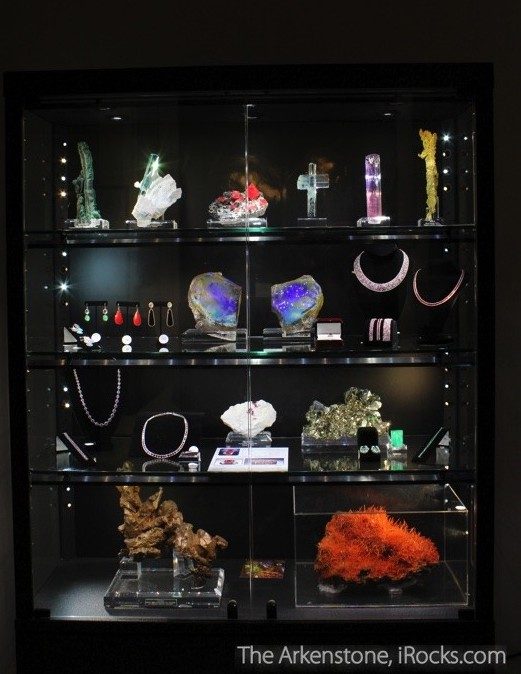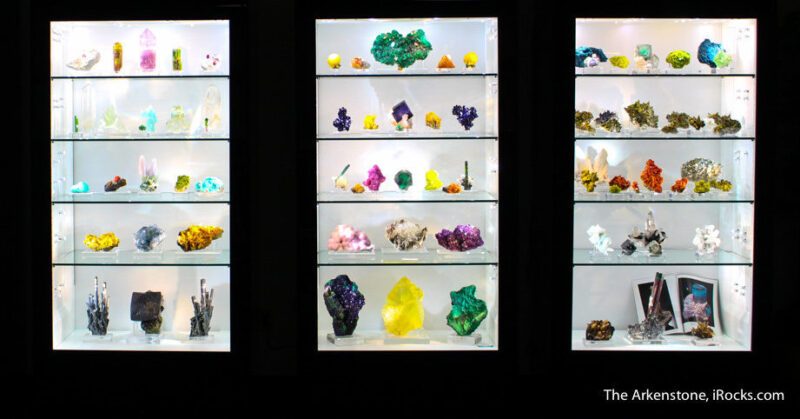How to Grow a Valuable Mineral Collection
Collecting rare rocks and minerals is like jumping into a time machine that lets you look back at the journey of Earth. Under high heat, pressure, and the watchful eye of time, rare rocks and minerals are born with an array of unique qualities that make the hobby exciting. Although massive collections are extraordinary things to look it, they can also come with a lot of work.

A spectacular case of fine minerals, gems, and jewelry from The Arkenstone at a private gallery show.
Whether you’re new to the hobby or a seasoned rockhound, it’s a great idea to plan the direction of your collection. Planning your collection will help you stay organized and maintain its value as you take on new specimens. As members of the rare rock and mineral collecting community, we’re always glad to offer insightful information about expanding the value of your collection.
Find What Interests You
The key to building a valuable collection is understanding the qualities about rare rock and mineral collecting that interests you. Take advantage of the many online publications and open field guides available to learn more about the types of rocks and minerals available. Are you collecting specimens of a specific family? Perhaps you want to focus your collection on origin or know a gemologist whose work you’d like to follow? Here are some publications to consider when doing research:

Fine minerals not only benefit from well-lit cases. Having the appropriate bases can help orient your specimens well, and they are much safer!
Dedicate a Space for Your Collection
Find a comfortable space in your home to show off your collection. Keep in mind that some rare rocks and minerals are reactive to sunlight and moisture. For example, some specimens of photochromic crystals like Kunzite permanently lose their deep pink color when exposed to too much sunlight.
You may want to consider investing in a front-window cabinet or display case to protect your specimens. Rare rocks and minerals like Sulfur, Ettringite, and Dioptase are fragile and can break if dropped or mishandled. By keeping them in a cabinet or display case, your collection will be safe in homes with small children and pets.
Know What to Look for On a Hunt
As your collection grows, you’ll want to start trading and selling less valuable rocks and minerals for rarer specimens. If you’re new to collecting, it’s likely that you have pieces of damaged crystals, rocks or gems. It can be difficult to spot damaged specimens early in your collection, but as you learn more curating and build relationships with dealers, you’ll gradually add more value to your collection.
More experienced collectors will want to find better quality specimens to replace less valuable ones in their collection. Some of the criteria that collectors use in evaluating the value of a specimen are:
- Size and Color
- Rarity
- Associated Minerals
- Luster and Transparency
- Damage and Repairs
- Locality, History and Provenance
Before you invest in a specimen, you’ll want to make sure that you have documentation of its locality, as the country and mine can be significant in determining value. There are many specimens in circulation that are poorly documented, so they might not be appreciated for provenance as much as they deserve.
Join a Community and Visit Collections
Collecting is more fun with a group of enthusiastic rockhounds. Consider joining a collector club for access to field trips, newsletters, socials and professional services. Most collector clubs visit mineral shows, symposiums, auctions and rare exhibits together to learn more about other collections.
The Arkenstone participates in mineral shows around the world, and we also are the founding sponsor of the Dallas Mineral Collecting Symposium. The annual symposium held each August features world-renowned speakers to share their latest collections and experiences in the field.
Don’t forget to check our listings for our shows. We’d love to meet with you and talk about the various collections!